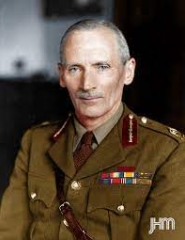Bernard L. Montogomery

Bernard L. Montogomery
BERNARD
L.
MONTOGOMERY
SOLDIER DETAILS
BIOGRAPHY
Bernard Law Montgomery "Monty" was born in London in 1887. After attending the Royal Military College at Sandhurst, he was commissioned into the Royal Warwickshire Regiment. Early in the First World War (1914-18), he was shot through the lung by a sniper during the First Battle of Ypres (1914). His wound was so severe that a grave was prepared for him. However, he went on to make a full recovery. He saw out the rest of the war as a staff officer, serving in the Battles of the Somme (1916) and Passchendaele (1917). In this capacity, he observed the tactics used by generals like Sir Douglas Haig and became critical of their readiness to accept high casualties during campaigns. When Britain declared war on Germany in 1939, Montgomery was sent to France with the British Expeditionary Force. He commanded the 3rd Division. Predicting the operation would be a disaster, he trained for tactical retreat. This proved vital during the evacuation of Dunkirk in 1940.In 1942, Prime Minister Winston Churchill appointed Montgomery commander of the Eighth Army in the Western Desert. Montgomery rapidly restored the army's flagging morale and ensured his men were properly supplied. For nearly two months, he continued to train and re-equip his soldiers.Montgomery effectively organised the defence of El Alamein against the German forces led by General Erwin Rommel. He countered both Italian and German attacks, before delivering the Allies their first major land victory of the war at the Second Battle of El Alamein in October 1942. This was a turning point in the North African campaign and indeed the Second World War.he was to return to Britain in January 1944. He was assigned to command the 21st Army Group consisting of all Allied ground forces participating in Operation Overlord, codename for the Allied invasion of Normandy. Overall direction was assigned to the Supreme Allied Commander of the Allied Expeditionary Forces, American General Dwight D. Eisenhower. Both Churchill and Eisenhower had found Montgomery difficult to work with in the past and wanted the position to go to the more affable General Sir Harold Alexander. However Montgomery's patron, General Sir Alan Brooke, firmly argued that Montgomery was a much superior general to Alexander and ensured his appointment. Without Brooke's support, Montgomery would have remained in Italy. After the war, Montgomery was made 1st Viscount of Alamein and appointed Commander-in-Chief of the British Army of the Rhine (BAOR) in Western Germany. Montgomery was arrogant, unlikeable, but ultimately successful. He famously lacked diplomacy and tact when dealing with others. But this directness made him a great military leader. Courtesy the National War Museum, nationalww2museum and Wikipedia.
 Eisenhower Foundation
Eisenhower Foundation
